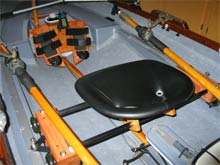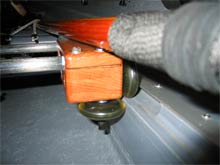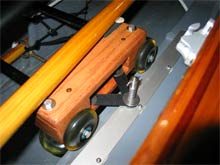| Question for John Welsford
John,
Three years ago, I acquired a 14 foot fiberglass rowing/sailing Whitehall type boat, and am having great fun rowing around the San Francisco Bay and Delta area. I am now thinking of building your Light Dory, because:
- The Whitehall weighs about 200 lb - a lighter rowing only boat would be easier to transport.
- I would like to build a wooden boat (never done this before)
- I like your designs, and may someday build a bigger craft
- The dory looks like it could handle rough water
Summer winds here tend to be 20 - 30 kt, making for challenging rowing. The Whitehall handles some pretty rough conditions but tends to turn away from the wind, which requires attention and effort to keep it from turning broadside to the waves. Do you know how the dory behaves in strong wind? It looks like the stern is a little higher than the bow, which may help it point into the wind.
The Whitehall also has a sliding seat that can be pinned in a fixed position. I have read your column on rowing, so know you are a fan of fixed seat. For me, it is a huge advantage to be able to use the fixed seat for a while, then change to slide seat and use leg muscles to get home. I suspect that a slide seat on the light dory would cause it to porpoise a lot, but do you know if anyone has built a sliding rigger for this boat?
Thanks in advance for the advice,
Rick
_________________
Hi Rick,
Thanks for the enquiry and the implied compliment. Yes the Light Dory is relatively neutral in cross winds, and if you need to alter then it's easy to carry what in the old days was called a "dory stone". In this case I'd suggest a 2 1/2 gallon plastic jerry full of water with 10 ft of light line attaching it to the center seat area. Going upwind you trim bow down by tossing it up in the bow, and when you want to be tracking well downwind you sling it back into the stern. While the boat's designed to be neutral so it will track well on all points, you can improve on that for longer stretches of rowing .
That high sheerline astern is to provide the right amount of windage to counter the big skeg underneath. That skeg is there to make it track straight when surfing!
Yes to the rough water, it's designed as a surf dory so will cope with conditions that most rowing boats wont.
Yes to the sliding seat, there are a number of those boats set up with riggers and sliding seats, the extra power is sometimes good to have and it does make for a better exersize regime. .
Yours, John
__________________
John,
I am encouraged to get started and build a great boat. Instead of the Dory, though, I really like the looks and the idea of the Walkabout. What do you think of this as a purely rowing boat? I would like to set it up for one person rowing slide seat, or for 2 people rowing fixed seat. My current boat is the Gig Harbor Whitehall, which has a convertible fixed/sliding seat arrangement I like a lot. Here are some pictures showing the system:
 |
This is the inside of the boat showing the tracks for the seat (the oars have bronze tubes as counterweights - an idea I got from you). People laugh at my tractor seat, but it is really comfortable even after 5 hours of rowing. |
 |
View of the rollers |
 |
View of the pin arrangement. Pop the pins out to release the slide seat. |
It looks like a similar arrangement could be done in the Walkabout. Do you see any problems with this?
The Whitehall is 14.5 feet long by 55 inch beam, weighing about 150 lb. On still water, I can row 3 to 3.5 kts for long distances, and just over 4 kts pulling hard. In a sprint, the GPS jumps around 4.5 to 5.5 kts, but that is the hull speed limit. Do you expect the Walkabout to have similar speed?
Thanks again,
Rick
________________
Hi Rick, that was quick!
Walkabout would be a lovely rowing boat, she was designed as a rowing boat that would sail rather than the other way around and fitting a slider is no problem. She would be noticeably faster than your Whitehall as she is longer.
Without the sailing rig she could be built somewhat lighter, and that would be a help as well.
I have drawings for a sliding seat designed for the Mollyhawk variation of Seagull, and I am sure that we can put the sheet of plans for that in with the Walkabout plans.
If there are more questions please feel free to ask
All the best for 2008
Yours, John W
|

